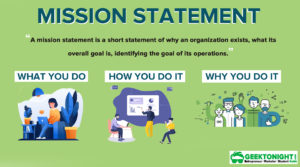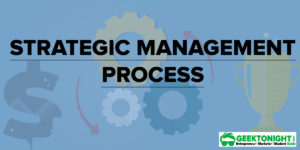What is Vision?
Vision can be defined as “a mental image of a possible and desirable future state of the organization” (Bennis and Nanus). It is “a vividly descriptive image of what a company wants to become in the future”. Vision represents top management’s aspirations about the company’s direction and focus. Every organization needs to develop a vision of the future. An articulated vision molds organizational identity positively stimulates managers and prepares the company for the future.
Table of Content
The first task in the process of strategic management is to formulate the organization’s vision and mission statements. These statements define the organizational purpose of a firm. Together with objectives, they form a “hierarchy of goals.”
A clear vision helps in developing a mission statement, which in turn facilitates the setting of objectives of the firm after analyzing the external and internal environment. Though vision, mission, and objectives together reflect the “strategic intent” of the firm, they have their distinctive characteristics and play important roles in strategic management.
“The critical point is that a vision articulates a view of a realistic, credible, attractive future for the organization, a condition that is better in some important ways than what now exists.”
According to Collins and Porras, a well-conceived vision consists of two major components:
- Core ideology
- Envisioned future
Core ideology is based on the enduring values of the organization (“what we stand for and why we exist”), which remain unaffected by environmental changes. Envisioned future consists of a long-term goal (what we aspire to become, to achieve, to create) that demands significant change and progress.
Definition of Vision
Vision has been defined in several different ways.
Richard Lynch defines vision as “a challenging and imaginative picture of the future role and objectives of an organization, significantly going beyond its current environment and competitive position.”
E1-Namaki defines it as “a mental perception of the kind of environment that an organization aspires to create within a broad time horizon and the underlying conditions for the actualization of this perception”.
Kotter defines it as “a description of something (an organization, corporate culture, a business, a technology, an activity) in the future.”
Several authors have given their definitions of organizational vision as per their findings and experiences, some of them are as follows:
Vision is a “clear mental picture of a future goal created jointly by a group for the benefit of other people, which is capable of inspiring and motivating those whose support is necessary for its achievement”. — Johnson
Vision is “an ideal that represents or reflects the shared values to which the organization should aspire”. — Kirkpatrick et. al.
Vision is “a picture or view of the future. Something not yet real, but imagined. What the organization could and should look like. Part analytical and part emotional”. — Thornberry
Vision is “the shared understanding of what the firm should be and how it must change”. — Shoemaker
Vision is “a picture of a destination aspired to, an end state to be achieved via the change. It reflects the larger goal needed to keep in mind while concentrating on concrete daily activities”. — Kanter et. al.
Vision is “an ambition about the future, articulated today, it is a process of managing the present from a stretching view of the future”. — Stace and Dunphy
Most refer to a future or ideal to which organizational efforts should be directed. The vision itself is presented as a picture or image that serves as a guide or goal. Depending on the definition, it is referred to as inspiring, motivating, emotional, and analytical. For Boal and Hooijberg, effective visions have two components:
- A cognitive component (which focuses on outcomes and how to achieve them)
- An affective component (which helps to motivate people and gain their commitment to it).
Nature of Vision
A vision represents an animating dream about the future of the firm. By its nature, it is hazy and vague. That is why Collins describes it as a Big Hairy Audacious Goal (BHAG). Yet it is a powerful motivator to action. It captures both the minds and hearts of people.
It articulates a view of a realistic, credible, attractive future for the organization, which is better than what now exists. Developing and implementing a vision is one of the leader’s central roles. He should not only have a “strong sense of vision”, but also a “plan” to implement it.
Example:
- Henry Ford’s vision of a “car in every garage” had power. It captured the imagination of others and aided internal efforts to mobilize resources and make it a reality. A good vision always needs to be a bit beyond a company’s reach, but progress toward the vision is what unifies the efforts of company personnel.
- One of the most famous examples of a vision is that of Disneyland “To be the happiest place on earth”. Other examples are:
- Hindustan Lever: Our vision is to meet the everyday needs of people everywhere.
- Microsoft: Empower people through great software at any time, any place, and on any device.
- Britannia Industries: Every third Indian must be a Britannia consumer.
- Hindustan Lever: Our vision is to meet the everyday needs of people everywhere.
Although such vision statements cannot be accurately measured, they do provide a fundamental statement of an organization’s values, aspirations, and goals.
Some more examples of vision statements are given below:
- “A Coke within arm’s reach of everyone on the planet” (Coca-Cola)
- “Encircle Caterpillar” (Komatsu)
- “Become the Premier Company in the World” (Motorola)
- “Put a man on the moon by the end of the decade” (John F. Kennedy, April 1961)
- “Eliminate what annoys our bankers and customers” (Texas Commerce Bank)
- “The one other copy” (Mobil).
Characteristics of Vision Statement
As may be seen from the above definitions, many of the characteristics of the vision given by these authors are common such as being clear, desirable, challenging, feasible, and easy to communicate. Nutt and Backoff have identified four generic features of visions that are likely to enhance organizational performance:
- Possibility means the vision should entail innovative possibilities for dramatic organizational improvements.
- Desirability means the extent to which it draws upon shared organizational norms and values about the way things should be done.
- Actionability means the ability of people to see the vision, and actions that they can take that are relevant to them.
- Articulation means that the vision has imagery that is powerful enough to communicate a picture of where the organization is headed.
Business Ethics
(Click on Topic to Read)
- What is Ethics?
- What is Business Ethics?
- Values, Norms, Beliefs and Standards in Business Ethics
- Indian Ethos in Management
- Ethical Issues in Marketing
- Ethical Issues in HRM
- Ethical Issues in IT
- Ethical Issues in Production and Operations Management
- Ethical Issues in Finance and Accounting
- What is Corporate Governance?
- What is Ownership Concentration?
- What is Ownership Composition?
- Types of Companies in India
- Internal Corporate Governance
- External Corporate Governance
- Corporate Governance in India
- What is Enterprise Risk Management (ERM)?
- What is Assessment of Risk?
- What is Risk Register?
- Risk Management Committee
Corporate social responsibility (CSR)
Lean Six Sigma
- Project Decomposition in Six Sigma
- Critical to Quality (CTQ) Six Sigma
- Process Mapping Six Sigma
- Flowchart and SIPOC
- Gage Repeatability and Reproducibility
- Statistical Diagram
- Lean Techniques for Optimisation Flow
- Failure Modes and Effects Analysis (FMEA)
- What is Process Audits?
- Six Sigma Implementation at Ford
- IBM Uses Six Sigma to Drive Behaviour Change
Research Methodology
Management
Operations Research
Operation Management
- What is Strategy?
- What is Operations Strategy?
- Operations Competitive Dimensions
- Operations Strategy Formulation Process
- What is Strategic Fit?
- Strategic Design Process
- Focused Operations Strategy
- Corporate Level Strategy
- Expansion Strategies
- Stability Strategies
- Retrenchment Strategies
- Competitive Advantage
- Strategic Choice and Strategic Alternatives
- What is Production Process?
- What is Process Technology?
- What is Process Improvement?
- Strategic Capacity Management
- Production and Logistics Strategy
- Taxonomy of Supply Chain Strategies
- Factors Considered in Supply Chain Planning
- Operational and Strategic Issues in Global Logistics
- Logistics Outsourcing Strategy
- What is Supply Chain Mapping?
- Supply Chain Process Restructuring
- Points of Differentiation
- Re-engineering Improvement in SCM
- What is Supply Chain Drivers?
- Supply Chain Operations Reference (SCOR) Model
- Customer Service and Cost Trade Off
- Internal and External Performance Measures
- Linking Supply Chain and Business Performance
- Netflix’s Niche Focused Strategy
- Disney and Pixar Merger
- Process Planning at Mcdonald’s
Service Operations Management
Procurement Management
- What is Procurement Management?
- Procurement Negotiation
- Types of Requisition
- RFX in Procurement
- What is Purchasing Cycle?
- Vendor Managed Inventory
- Internal Conflict During Purchasing Operation
- Spend Analysis in Procurement
- Sourcing in Procurement
- Supplier Evaluation and Selection in Procurement
- Blacklisting of Suppliers in Procurement
- Total Cost of Ownership in Procurement
- Incoterms in Procurement
- Documents Used in International Procurement
- Transportation and Logistics Strategy
- What is Capital Equipment?
- Procurement Process of Capital Equipment
- Acquisition of Technology in Procurement
- What is E-Procurement?
- E-marketplace and Online Catalogues
- Fixed Price and Cost Reimbursement Contracts
- Contract Cancellation in Procurement
- Ethics in Procurement
- Legal Aspects of Procurement
- Global Sourcing in Procurement
- Intermediaries and Countertrade in Procurement
Strategic Management
- What is Strategic Management?
- What is Value Chain Analysis?
- Mission Statement
- Business Level Strategy
- What is SWOT Analysis?
- What is Competitive Advantage?
- What is Vision?
- What is Ansoff Matrix?
- Prahalad and Gary Hammel
- Strategic Management In Global Environment
- Competitor Analysis Framework
- Competitive Rivalry Analysis
- Competitive Dynamics
- What is Competitive Rivalry?
- Five Competitive Forces That Shape Strategy
- What is PESTLE Analysis?
- Fragmentation and Consolidation Of Industries
- What is Technology Life Cycle?
- What is Diversification Strategy?
- What is Corporate Restructuring Strategy?
- Resources and Capabilities of Organization
- Role of Leaders In Functional-Level Strategic Management
- Functional Structure In Functional Level Strategy Formulation
- Information And Control System
- What is Strategy Gap Analysis?
- Issues In Strategy Implementation
- Matrix Organizational Structure
- What is Strategic Management Process?
Supply Chain






